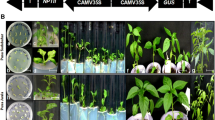Abstract
Transgenic Washington navel orange [Citrus sinensis (L.) Osbeck] plants were obtained using Agrobacterium-mediated transformation of seedling epicotyl tissue. An average of 45% (58 out of 128 segments) of the epicotyl segments produced shoots expressing the β-glucuronidase (GUS)-intron reporter gene when using Agrobacterium strain C58 C1, compared to 29% (38 out of 128 segments) for EHA101-5 and 0% for LBA4404. Co-culture of 21-day-old Washington navel epicotyl stem segments gave greater transformation efficiency than co-culture of 35- or 56-day-old stem segments. After 6 weeks, regenerated shoots were micro-grafted in vivo onto seedling rootstocks of Carrizo citrange. Stable integration of the transgene sequence was confirmed by expression of the plant intron-containing GUS gene, PCR and Southern hybridization. The apomictic (non-zygotic) state of the transgenic plants was confirmed by isoenzyme and random amplified polymorphic DNA analyses. More than 50 transgenic plants have been obtained and are growing in the greenhouse.
Similar content being viewed by others
Author information
Authors and Affiliations
Additional information
Received: 14 April 1998 / Revision received: 9 June 1998 / Accepted: 8 July 1998
Rights and permissions
About this article
Cite this article
Bond, J., Roose, M. Agrobacterium-mediated transformation of the commercially important citrus cultivar Washington navel orange. Plant Cell Reports 18, 229–234 (1998). https://doi.org/10.1007/s002990050562
Issue Date:
DOI: https://doi.org/10.1007/s002990050562




